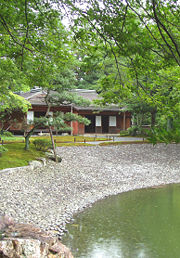
Sento Imperial Palace
Encyclopedia

Kyoto
is a city in the central part of the island of Honshū, Japan. It has a population close to 1.5 million. Formerly the imperial capital of Japan, it is now the capital of Kyoto Prefecture, as well as a major part of the Osaka-Kobe-Kyoto metropolitan area.-History:...
, Japan
Japan
Japan is an island nation in East Asia. Located in the Pacific Ocean, it lies to the east of the Sea of Japan, China, North Korea, South Korea and Russia, stretching from the Sea of Okhotsk in the north to the East China Sea and Taiwan in the south...
, formerly the grounds of a palace for retired emperors (Emperor Daijō). It is administered by the Imperial Household Agency
Imperial Household Agency
The is a government agency of Japan in charge of the state matters concerning Japan's imperial family and also keeping the Privy Seal and the State Seal...
and may be visited by appointment.
Sento Imperial Palace was completed in 1630 for Emperor Go-Mizunoo
Emperor Go-Mizunoo
was the 108th Emperor of Japan, according to the traditional order of succession.Go-Mizunoo's reign spanned the years from 1611 through 1629.This 17th century sovereign was named after the 9th century Emperor Seiwa and , translates literally as "later;" and thus, he could be called the "Later...
's retirement, along with the corresponding Ōmiya Palace for the Empress Dowager Nyoin. Both palaces were repeatedly destroyed by fire and reconstructed until a blaze in 1854, after which the Sento palace was never rebuilt. (Ōmiya Palace was, however, reconstructed in 1867 and is still used by the emperor whenever he visits Kyoto). Today only two Sento structures, the Seika-tei and Yushin-tei teahouses, remain. The excellent gardens, laid out in 1630 by renowned artist Kobori Masakazu
Kobori Masakazu
, better known as ', was a notable Japanese artist and aristocrat in the reign of Tokugawa Ieyasu.In 1604, Kobori received as inheritance a 12,000-koku fief in Ōmi Province at Komuro. He excelled in the arts of painting, poetry, flower arrangement, and garden design...
(Kobori Enshu), are now its main attractions.
Sento palace grounds are located within the southeast corner of the Kyoto Imperial Palace
Kyoto Gosho
The is an imperial palace of Japan, though the Emperor of Japan is not in residence. The Emperor has resided at the Tokyo Imperial Palace since 1869 and ordered the preservation of the Kyōto Imperial Palace in 1877....
, and entered via a stately wooden gate within its surrounding earthen wall. A carriage house with graceful triple gables (Okuruma-Yosi) sits just within, but still outside the garden's unadorned inner wall, whose gate leads directly to a fine view opening westward across the garden pond.
The garden's primary feature is a large pond with islands and walkways, whose north and south segments were linked by a short canal in 1747. The north pond was extended and reworked from 1684-1688; the south pond is notable for its expansive "ocean shore" of rounded stones and cherry trees, an edging of mixed natural and hewn stones, and a separate, understated embankment of squared stones. The ponds contain a variety of highly picturesque islands and six bridges in a varied styles, including one with an impressive wisteria
Wisteria
Wisteria is a genus of flowering plants in the pea family, Fabaceae, that includes ten species of woody climbing vines native to the eastern United States and to China, Korea, and Japan. Aquarists refer to the species Hygrophila difformis, in the family Acanthaceae, as Water Wisteria...
trellis (built 1895).
Two teahouses complete the garden: Seika-tei, shingle-roofed and spare, at the southern end of the south pond; and Yushin-tei, thatched and rustic with a notable round window, at the western side of the north pond.

